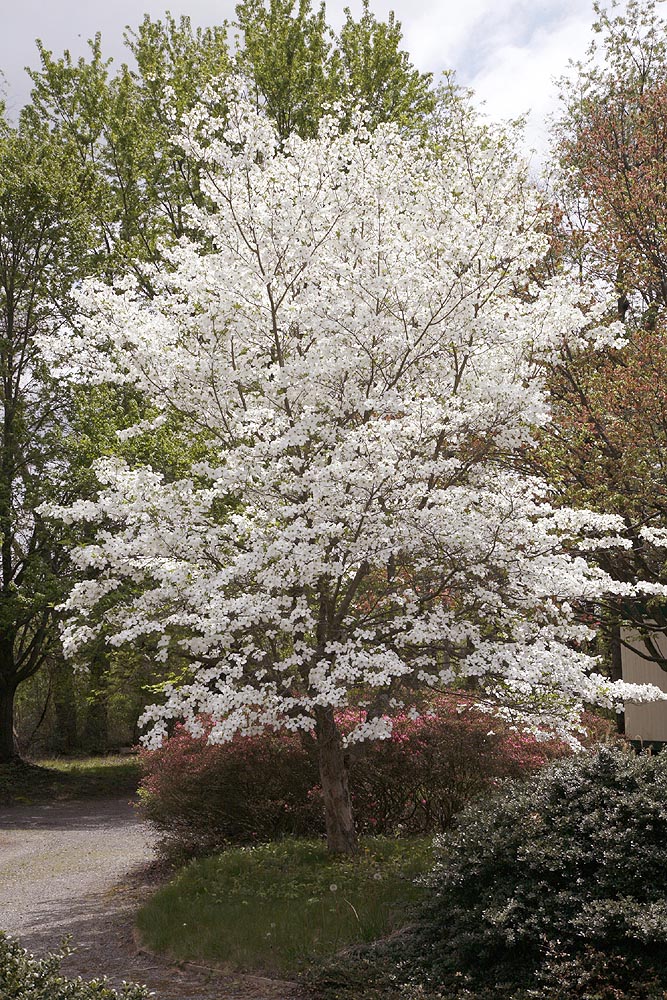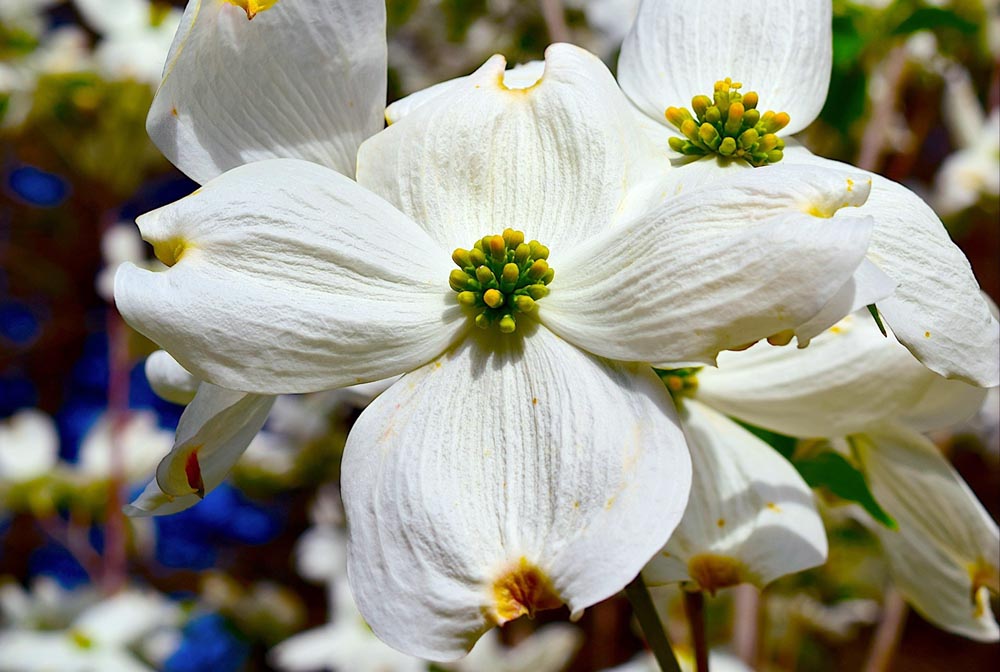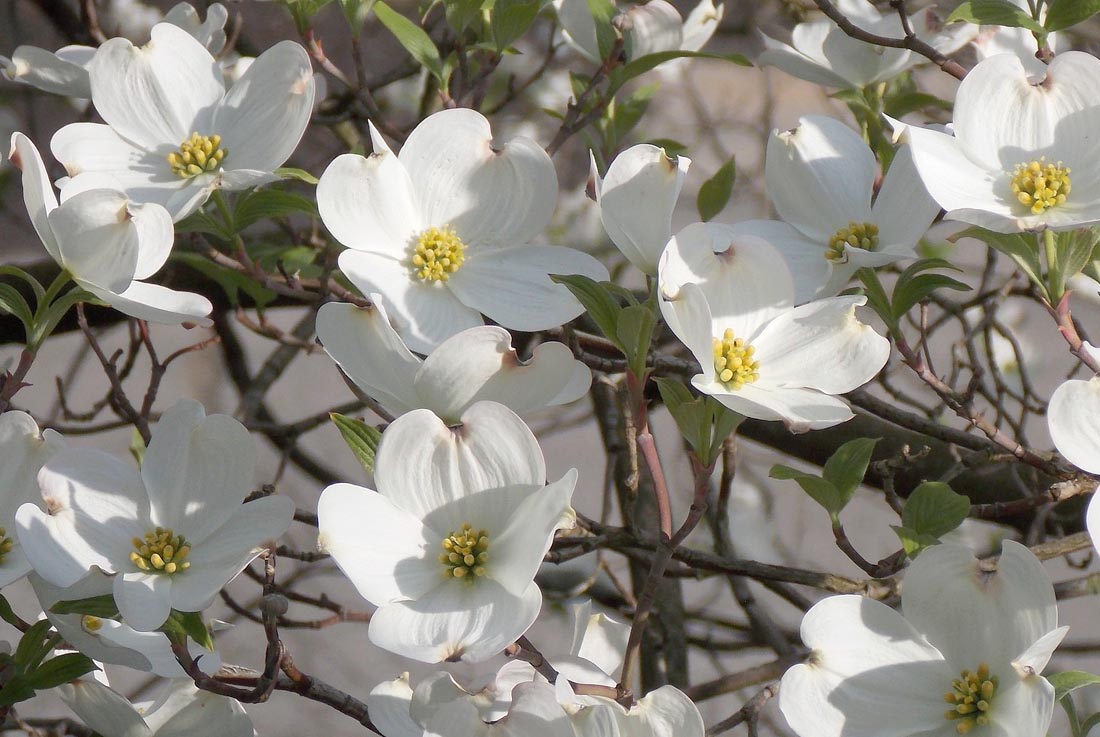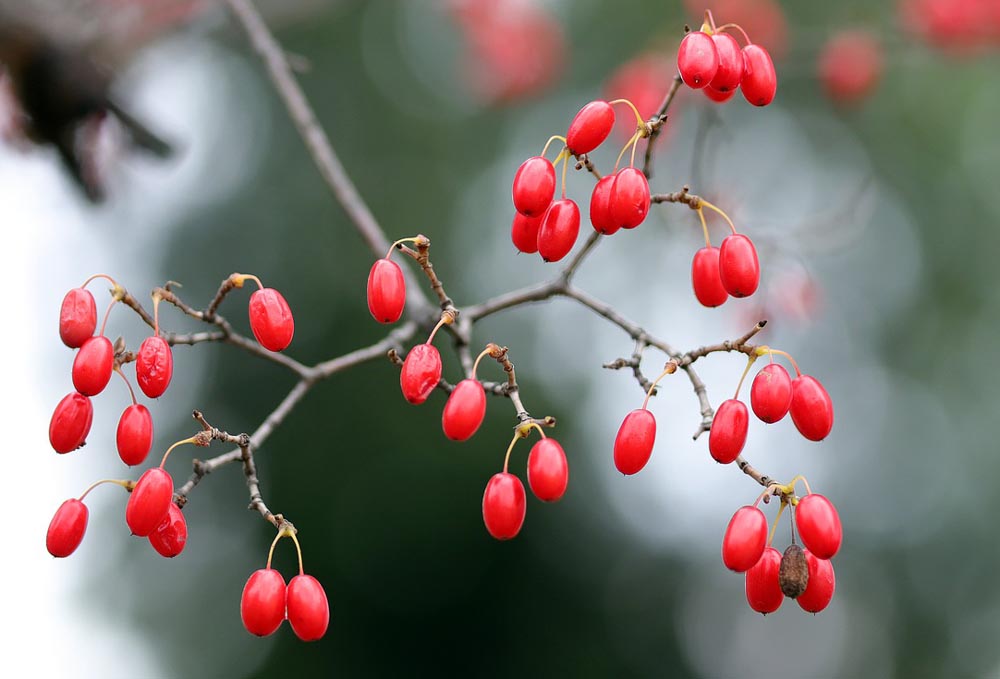A lovely Native American small tree that produces masses of white flowers in early to mid spring that last for several weeks. Reaching a height of only 35 feet (10.6 m) this small tree is often grown as an ornamental. In the wild it grows as an understory tree in open forests but it shows its true beauty if allowed to stand along and develop and broad shape with a semi flattened crown. The leaves turn a lovely burgundy scarlet in the autumn giving two shows of beauty the small red fruits are beloved by birds and small creatures and butterflies love the early flowers. Its a very easy tree to grow and flowers after about 5 years from seed and needs little care once established. Grow your own trees.
Description of Flowering Dogwood (Cornus Florida).
A small native American tree that grows in the understory of a typical forest reaching about 35-40 feet (10-12m) in height. It has a wide spreading habit with open branches and a relatively flat crown. The leaves are oval or ovate with a pointed tip 3-6 inches (7.6-15cm) long and 1-3 inches (2.5- .6cm) wide. Leaves are deeply veined mid to dark green with slightly lighter undersides and prominent veins standing out. In autumn the leaves turn dark crimson to burgundy before being shed. In early to mid spring the flowers appear before the leaves in clusters at the tips of each small branchlet. Flowers of native trees are white but some cultivars have been created that are pink. The 'petals' are not true petals but modified bracts and elongate from the overwintering bud in early spring. these are mostly oval with a distinct notch in the flattened tip. The four 'petals' form a distinct flat cross shape 3-4 inches (7.6-10 cm) in diameter in the center of which is the true flower. This is a circular half dome consisting of a group of tiny yellow-green four petaled flowers. Flowers last about 3-4 weeks and are followed by small cylindrical bright red fruits (8-18 mm) long that can persist until late fall. Trees are hardy from zone 5-9 and fairly long lived.
Growing Flowering Dogwood (Cornus Florida) from Seed.
Seeds need to be stratified before they germinate. All our seeds are kept in cold conditions so the process is partially complete. Some moist stratification is also recommended and can be carried out using several different methods depending on the time of year and your requirements. See our
Stratification Instructions for full details.
Many sources suggest the seeds need 120 days of moist stratification. If you have the time to do this they it may be worth it. We suggest no less than 60 days since our seed has already been kept cold, a refrigerator can do the job just as well so it is not necessary to start your seeds in the fall or winter to achieve success your seedlings will just be a little later starting.
Plant seeds in small pots, either one each or 2-3 to a pot with the intension of removing all but the strongest once they are growing. Once germinated seedlings grow rapidly and can reach 12-14 inches (31-35.5cm) in their first year. Transplant seedlings to larger pots as they grow and once they reach about 8 inches (20.3cm) tall they can be planted out if desired. If you want to keep your trees in pots for longer ensure the pots are deep enough to accommodate the tree roots which will grow longer and deeper than most other plants. If the trees become root bound in the pot it can stunt any further growth once transplanted out.
When planting seedlings out, check to ensure that the plant is not pot bound. If there is a mass of roots circling the pot carefully tease the roots out and lay them out. If roots are circling they must be straightened or if necessary removed before the planting. If allowed to continue to circle they could for a girdling root once the plant begins to grow, this can strangle the plant and cause it to die.
Trees usually flower about five years from seed. All seeds will produce white flowering trees, which is the native and dominate color. Pink cultivar trees can only be obtained from grafting. For more details see our Growing Trees from Seeds article.
Location and Care of Flowering Dogwood (Cornus Florida).
Trees do well in full sun especially in cooler zones 5-7, in warmer zones partial shade can be tolerated but some full sun is suggested. This tree is a native understory tree so it tolerates semi shade well but cooler zones get less light so it needs more. Plant away from other trees to allow the tree to develop a wide branching state that gives the tree so much of its beauty. Pick a spot that has good air flow this keeps the likelihood of disease low.
Its not fussy about soil type and will grow in most soils provided they drain well, does not like wet soils. A richer soil with good organic material will produce a stronger healthier tree. Placing 2-4 inches (5-10 cm) of mulch around the tree roots on a yearly basis will ensure that it stays healthy. Dogwoods have shallow roots so a layer of mulch will help to keep the moisture on the soil, keep the soil and roots cooler in the hot summer months and reduce the possibility of leaf scorch that can occur during droughts. Do not mulch right up to the trunk leave at least 6 inches (15.2 cm) to prevent bark rot and rodent attacks.
Diseases of Flowering Dogwood (Cornus Florida).
Its a native American tree so of course many other native species have evolved to feed on it. Calico scale, dogwood borer, dogwood sawfly, Japanese maple scale, leafhoppers, oyster shell scale can be a problem. It can also be susceptible to powdery mildew, leaf spot, canker, root rot and leaf, twig blight crown canker, bacterial leaf scorch, powdery mildew, and septoria leaf spot. Dogwood anthracnose is also a growing problem but mostly in warmer states humidity or those close to water. It some southern states it is decimating the wild populations but trees in dryer less humid locations do best.
Pollinator and Wildlife with Flowering Dogwood (Cornus Florida).
The flowers attract butterflies and several native bee species as well as other pollinators. The berries are enjoyed by wildlife mostly squirrels chipmunks and birds. Nocturnal mammals also eat the fruits. The low branches may be susceptible to deer browsing.
Harvesting Flowering Dogwood (Cornus Florida).
Fruits can be harvested when they are full red ripe. They can easily be picked off lower branches by hand. Keep an eye on your chosen trees to ensure you get there before the birds take them all.
Culinary Uses of Flowering Dogwood (Cornus Florida).
While some sources suggest the fruits are poisonous they are not but cannot be eaten raw. They, like all the plant are strongly astringent which is most likely where the idea they are poisonous came from. They do however need a lot of preparation and mixing with other fruits to make them palatable. First the berries are mashed and cooked then added to other fruits to be turned into jams and jellies. This suggests they are used more as a 'bulking agent' to make other fruits go farther, possibly because food was scarce or in times of need. Since fruits are small and the amount of work great to make them edible it is most likely not worth the effort in times when so many other sources are plentiful.
Medical uses of Flowering Dogwood (Cornus Florida).
There are many reports stating the plant was used by Native Americans as a medicine. It was valued for its strong astringent properties, almost the whole plant contains astringent compounds from the flowers, leaves bark and root. For the most part original uses have most likely been lost those remaining suggest use to treat diarrhea, reduce fevers, restore lost voice, expel worms and as a digestive bitter tonic. Other treatments suggest that it was used by early settlers or adapted by Native Americans to treat diseases that arrived with the colonists such as treatment malaria, measles and to restore tone to the stomach in cases of alcoholism.
Other uses of Flowering Dogwood (Cornus Florida).
A scarlet dye can be made from this tree as well as a good passable ink. Frayed small twigs can be used as a natural toothbrush with the strong tannins offering an antiseptic quality to keep teeth and gums healthy. The wood is dense and hard and often used to fashion small tools, handles butcher blocks and golf clubs.
Why Dogwood?
The common name, dogwood, comes from England. Years ago, people there used the bark of the bloodtwig dogwood (
Cornus sanguinea) to bathe mangy dogs










